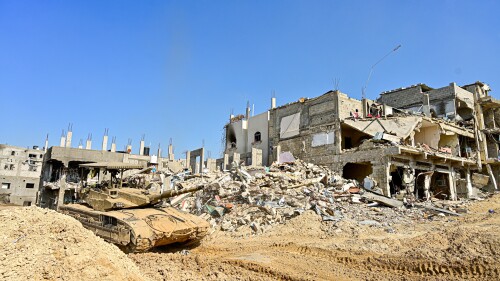Mourners surround the truck carrying the coffin of Islamic Revolutionary Guard Corps Col. Hassan Sayad Khodaei at his May 24 funeral in Tehran. |
The killing of Iranian Col. Hassan Khodaei outside his Tehran home signaled a major shift in Israel’s strategy toward Iran. The Jewish state’s apparently considerable efforts on Iranian soil had formerly been directed at the Iranian nuclear program. But Jerusalem seems to have adopted a broader definition of the challenge it faces—and the measures it will adopt to address it.
Khodaei, who was killed May 22, had no known connection to the nuclear program. Rather, he was one of the most seasoned special-operations men in the Quds Force, a branch of the Islamic Revolutionary Guard Corps. Khodaei was engaged in external operations said to include kidnappings and assassinations. He played an important role in the transfer of drone and missile technology to Lebanese Hezbollah, Tehran’s key regional proxy. According to Hebrew media reports, he was in the midst of masterminding a plan for the abduction of Israelis overseas at the time of his demise.
Khodaei’s killing was the second known operation carried out this year by Israel on Iranian soil against a target unconnected to Tehran’s nuclear program, and the first to directly target a specific individual. An earlier strike, at an air base at Kermanshah in mid-February, destroyed hundreds of drones.
Israeli operations on Iranian soil in recent years have included the theft of the Iranian nuclear archive in 2018, the killings of scientists associated with the nuclear program, and probably also acts of sabotage against nuclear facilities, such as the December 2021 explosion at the enrichment complex at Natanz. These actions indicate that Israel has succeeded in thoroughly penetrating Iran’s defenses.
More broadly, Israel has engaged in a shadow war against Iranian efforts at power-building across the Middle East. Israeli air power has been active in disrupting and damaging Iranian infrastructure in Syria. Individual assassinations have taken place in Syria and probably also in Lebanon. Israeli planes have struck as far afield as Iraq.
But the extension of Israel’s campaign against Iran’s nonnuclear subversive activities onto Iranian soil is a new development and a significant escalation. Such a change isn’t merely tactical in nature, and a decision to adopt it wouldn’t have been taken without the prime minister’s approval. The growing perception in Israel is that the Iranian nuclear program can’t be seen in isolation from Tehran’s broader strategy for regional domination.
Prime Minister Naftali Bennett has long been vocal in support of this view. While serving as defense minister in February 2020, Mr. Bennett told Israeli reporters: “When the octopus tentacles hit you, you must fight back not just against the tentacles, but also make sure to suffocate the head. . . . For years on end, we have fought against the Iranian tentacles in Lebanon, Syria and the Gaza Strip, but we have not focused enough on weakening Iran itself. Now we are changing the paradigm.”
In June, 2020, the Israel Defense Forces established the Strategy and Third Circle Directorate, assigned to formulate a comprehensive view of the Iranian threat facing Israel in all its aspects. It now appears that this approach is being extended to the sphere of action. Israel sees Iran as engaged in a comprehensive, strategic drive intended to result in Tehran’s emergence as the dominant or hegemonic power in the Middle East. The destruction of Israel is a key element in this strategy. This project focuses on political and proxy military activity, investment in Iran’s ballistic missile program, and the development of a nuclear capacity intended as a kind of insurance policy for the other two elements.
The Jewish state, in turn, is in the process of formulating and implementing a comprehensive response. A counterenvelopment of Iran through deepening ties with states surrounding it—including Azerbaijan to the north and the United Arab Emirates, Bahrain and Saudi Arabia to the southwest—forms part of this approach. Israel’s 2021 transfer to the U.S. Central Command’s area of responsibility offers potential for making these growing links operational in key areas, such as missile defense.
It appears that a bold change of the rules of engagement, in which the totality of Iranian strategy will now be opposed also on Iranian soil, forms an additional component of this effort. The strike on the drone fleet at Kermanshah and the killing of Khodaei in Tehran were the first manifestations of this new approach. Three additional unexplained deaths of senior Iranian security personnel have occurred in subsequent weeks. The shadow war between Israel and Iran has entered a new phase.
Jonathan Spyer is a Ginsburg/Milstein Writing Fellow at the Middle East Forum and director of the Middle East Center for Reporting and Analysis.








